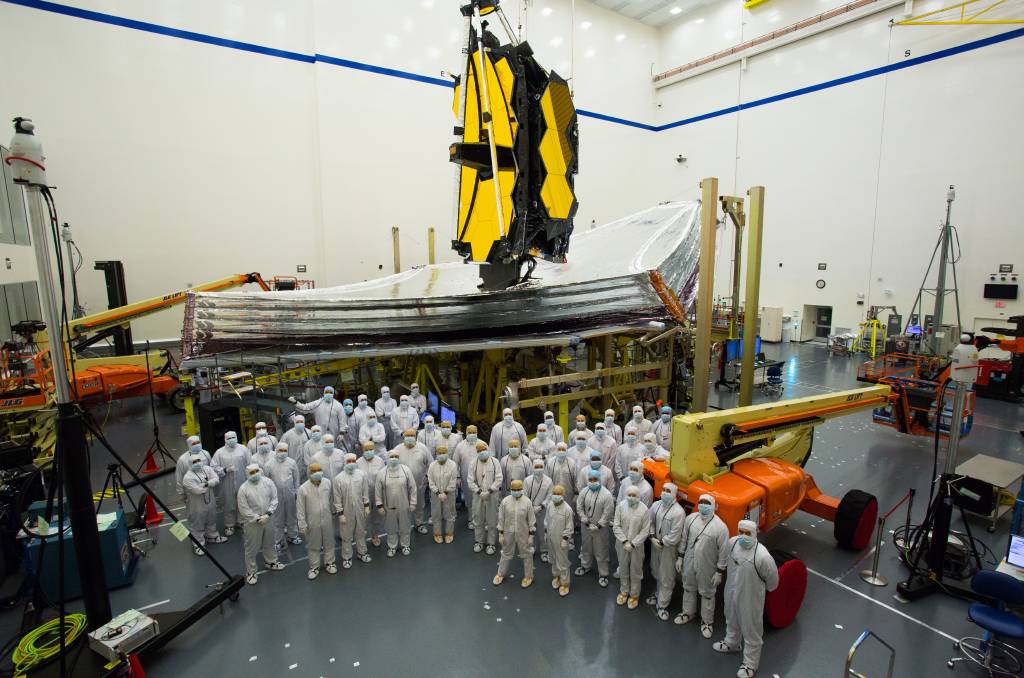Hundreds of thousands of kilometres above us, a great unfurling has begun, with Canberra’s Deep Space Communications Network at Tidbinbilla playing a crucial role.
While much of the western world was focused on stuffing turkeys and wrapping presents at Christmas, the largest and most complex piece of industrial origami since the first components of the International Space Station were launched into space 23 years ago, blasted off from the European Space Agency’s pad in French Guinea.
Named in honour of the former head of NASA during the critical period in the lead-up to putting the first humans on the moon, the $9.6 billion James Webb telescope is now on a month-long journey to its final observation post, 1.5 million kilometres from earth.
There’s no guarantees that it will make it all the way. Getting it into space was the relatively easy part.
Now comes that which NASA insiders have described as “29 days on the edge”.
Excellent signal from @NASAWebb through our antennas.????@GoldstoneDSN is now controlling the Deep Space Network.
When we take control at 9amAEDT, we will be supporting Webb for its mid-course correction engine burn.
A crucial event on its journey to Lagrange point #2 (L2). pic.twitter.com/W8s55IAqfT— CanberraDSN (@CanberraDSN) December 25, 2021
The telescope’s target location is what’s known as LaGrange Point Two. It’s where objects sent from here tend to – but not always – stay put, trapped by gravitational forces. It’s here that the giant telescope will be pointed into deep space over the next 10 years, seeking out the mysteries of the universe.
As the spacecraft speeds to its destination, the great unfurling has slowly, painstakingly begun. Motors, rods, sliders, pulleys and actuators – a myriad of very expensive components – will be keyed to allow this slow-motion choreograph of self-assembly.
Northrop Grumman, which built the B2 Stealth Bomber and engineered the F35 joint strike fighter, is responsible for building the telescope and the crucial deployment componentry.
But if those aircraft are marvels of modern engineering, this 6.5 tonne craft is in another league again.
Everything tested and re-tested back in the lab now has to work perfectly because there’s no astronaut servicing option available this far out, unlike the Hubble telescope which has been tweaked five times – probably the most expensive service package in human history – since 1993.
When the Webb telescope’s gimballed, high-gain antenna was deployed hours after launch, the Tidbinbilla tracking station south of Canberra was the first to receive the signal. For 10 hours a day, the Canberra Deep Space Network will monitor Webb’s progress, handing over to its sister stations in California and Spain.
As the spacecraft speeds on its trajectory, separate elements will awaken. The sunshields are already successfully out and the tower assembly is next, followed by the instrument radiator, momentum flaps and then finally its 18 thin, lightweight beryllium mirror segments.
READ MORE:
Positioning the telescope in the optimum place in space is critical.
Overexposed to the sun and its delicate instruments would fry. As effective as the Webb’s five-layered sunshield is, too much heat would be curtains.
Consider, too, the thermal difference between one side of the spacecraft and the other. On the sun side, temperatures could be 170 degrees Celcius, while the sun shield keeps the other side cold enough for the scientific instruments to perform, which is near absolute zero (minus 273 Celcius).
Every one of the hundreds of various elements which make up this space ballet are all keyed by command from earth, with fingers firmly crossed.
The telescope fully deployed during testing, showing its scale, with the engineers and technicians responsible for its construction. Picture: Northrop Grumman
Once successfully deployed in a few weeks, the multi-layered sunshield will begin to cool the spacecraft.
Back on earth, the team at the Goddard Space Flight Centre in Greenbelt, Maryland, watches and waits. The first careful steps toward witnessing the birth of stars, supernova and millions of galaxies far fainter than the Hubble telescope can see, have begun.


























